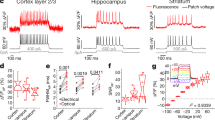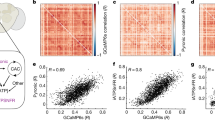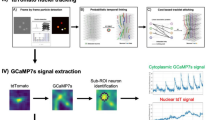Abstract
Existing techniques for monitoring neural activity in awake, freely behaving vertebrates are invasive and difficult to target to genetically identified neurons. We used bioluminescence to non-invasively monitor the activity of genetically specified neurons in freely behaving zebrafish. Transgenic fish with the Ca2+-sensitive photoprotein green fluorescent protein (GFP)-Aequorin in most neurons generated large and fast bioluminescent signals that were related to neural activity, neuroluminescence, which could be recorded continuously for many days. To test the limits of this technique, we specifically targeted GFP-Aequorin to the hypocretin-positive neurons of the hypothalamus. We found that neuroluminescence generated by this group of ∼20 neurons was associated with periods of increased locomotor activity and identified two classes of neural activity corresponding to distinct swim latencies. Our neuroluminescence assay can report, with high temporal resolution and sensitivity, the activity of small subsets of neurons during unrestrained behavior.
This is a preview of subscription content, access via your institution
Access options
Subscribe to this journal
Receive 12 print issues and online access
$209.00 per year
only $17.42 per issue
Buy this article
- Purchase on Springer Link
- Instant access to full article PDF
Prices may be subject to local taxes which are calculated during checkout






Similar content being viewed by others
References
Kralik, J.D. et al. Techniques for long-term multisite neuronal ensemble recordings in behaving animals. Methods 25, 121–150 (2001).
Miller, E.K. & Wilson, M.A. All my circuits: using multiple electrodes to understand functioning neural networks. Neuron 60, 483–488 (2008).
Luo, L., Callaway, E.M. & Svoboda, K. Genetic dissection of neural circuits. Neuron 57, 634–660 (2008).
Brustein, E., Marandi, N., Kovalchuk, Y., Drapeau, P. & Konnerth, A. In vivo monitoring of neuronal network activity in zebrafish by two-photon Ca2+ imaging. Pflugers Arch. 446, 766–773 (2003).
Douglass, A.D., Kraves, S., Deisseroth, K., Schier, A.F. & Engert, F. Escape behavior elicited by single, Channelrhodopsin-2–evoked spikes in zebrafish somatosensory neurons. Curr. Biol. 18, 1133–1137 (2008).
Niell, C.M. & Smith, S.J. Functional imaging reveals rapid development of visual response properties in the zebrafish tectum. Neuron 45, 941–951 (2005).
Ramdya, P. & Engert, F. Emergence of binocular functional properties in a monocular neural circuit. Nat. Neurosci. 11, 1083–1090 (2008).
O'Malley, D.M., Kao, Y.H. & Fetcho, J.R. Imaging the functional organization of zebrafish hindbrain segments during escape behaviors. Neuron 17, 1145–1155 (1996).
Higashijima, S., Masino, M.A., Mandel, G. & Fetcho, J.R. Imaging neuronal activity during zebrafish behavior with a genetically encoded calcium indicator. J. Neurophysiol. 90, 3986–3997 (2003).
Orger, M.B., Kampff, A.R., Severi, K.E., Bollmann, J.H. & Engert, F. Control of visually guided behavior by distinct populations of spinal projection neurons. Nat. Neurosci. 11, 327–333 (2008).
McLean, D.L., Fan, J., Higashijima, S., Hale, M.E. & Fetcho, J.R. A topographic map of recruitment in spinal cord. Nature 446, 71–75 (2007).
Gahtan, E., Sankrithi, N., Campos, J.B. & O'Malley, D.M. Evidence for a widespread brain stem escape network in larval zebrafish. J. Neurophysiol. 87, 608–614 (2002).
Dombeck, D.A., Khabbaz, A.N., Collman, F., Adelman, T.L. & Tank, D.W. Imaging large-scale neural activity with cellular resolution in awake, mobile mice. Neuron 56, 43–57 (2007).
Briggman, K.L., Abarbanel, H.D. & Kristan, W.B. Jr. Optical imaging of neuronal populations during decision-making. Science 307, 896–901 (2005).
Clark, D.A., Gabel, C.V., Gabel, H. & Samuel, A.D. Temporal activity patterns in thermosensory neurons of freely moving Caenorhabditis elegans encode spatial thermal gradients. J. Neurosci. 27, 6083–6090 (2007).
Baubet, V. et al. Chimeric green fluorescent protein-aequorin as bioluminescent Ca2+ reporters at the single-cell level. Proc. Natl. Acad. Sci. USA 97, 7260–7265 (2000).
Daunert, S. & Deo, S.K. Photoproteins in Bioanalysis. (Wiley-VCH, Weinheim, Germany, 2006).
Smith, S.J. & Zucker, R.S. Aequorin response facilitation and intracellular calcium accumulation in molluscan neurones. J. Physiol. (Lond.) 300, 167–196 (1980).
Ashley, C.C. & Ridgway, E.B. Simultaneous recording of membrane potential, calcium transient and tension in single muscle fibers. Nature 219, 1168–1169 (1968).
Hastings, J.W. & Johnson, C.H. Bioluminescence and chemiluminescence. Methods Enzymol. 360, 75–104 (2003).
Shimomura, O., Musicki, B., Kishi, Y. & Inouye, S. Light-emitting properties of recombinant semi-synthetic aequorins and recombinant fluorescein-conjugated aequorin for measuring cellular calcium. Cell Calcium 14, 373–378 (1993).
Curie, T., Rogers, K.L., Colasante, C. & Brulet, P. Red-shifted aequorin-based bioluminescent reporters for in vivo imaging of Ca2+ signaling. Mol. Imaging 6, 30–42 (2007).
Martin, J.R., Rogers, K.L., Chagneau, C. & Brulet, P. In vivo bioluminescence imaging of Ca signalling in the brain of Drosophila. PLoS One 2, e275 (2007).
Rogers, K.L. et al. Non-invasive in vivo imaging of calcium signaling in mice. PLoS One 2, e974 (2007).
Rogers, K.L. et al. Visualization of local Ca2+ dynamics with genetically encoded bioluminescent reporters. Eur. J. Neurosci. 21, 597–610 (2005).
Cheung, C.Y., Webb, S.E., Meng, A. & Miller, A.L. Transient expression of apoaequorin in zebrafish embryos: extending the ability to image calcium transients during later stages of development. Int. J. Dev. Biol. 50, 561–569 (2006).
Teranishi, K. & Shimomura, O. Solubilizing coelenterazine in water with hydroxypropyl-β-cyclodextrin. Biosci. Biotechnol. Biochem. 61, 1219–1220 (1997).
Baraban, S.C. Emerging epilepsy models: insights from mice, flies, worms and fish. Curr. Opin. Neurol. 20, 164–168 (2007).
Tallini, Y.N. et al. Imaging cellular signals in the heart in vivo: cardiac expression of the high-signal Ca2+ indicator GCaMP2. Proc. Natl. Acad. Sci. USA 103, 4753–4758 (2006).
Park, H.C. et al. Analysis of upstream elements in the HuC promoter leads to the establishment of transgenic zebrafish with fluorescent neurons. Dev. Biol. 227, 279–293 (2000).
Sakurai, T. The neural circuit of orexin (hypocretin): maintaining sleep and wakefulness. Nat. Rev. Neurosci. 8, 171–181 (2007).
Prober, D.A., Rihel, J., Onah, A.A., Sung, R.J. & Schier, A.F. Hypocretin/orexin overexpression induces an insomnia-like phenotype in zebrafish. J. Neurosci. 26, 13400–13410 (2006).
Yokogawa, T. et al. Characterization of sleep in zebrafish and insomnia in hypocretin receptor mutants. PLoS Biol. 5, e277 (2007).
Chemelli, R.M. et al. Narcolepsy in orexin knockout mice: molecular genetics of sleep regulation. Cell 98, 437–451 (1999).
Lin, L. et al. The sleep disorder canine narcolepsy is caused by a mutation in the hypocretin (orexin) receptor 2 gene. Cell 98, 365–376 (1999).
Mileykovskiy, B.Y., Kiyashchenko, L.I. & Siegel, J.M. Behavioral correlates of activity in identified hypocretin/orexin neurons. Neuron 46, 787–798 (2005).
Lee, M.G., Hassani, O.K. & Jones, B.E. Discharge of identified orexin/hypocretin neurons across the sleep-waking cycle. J. Neurosci. 25, 6716–6720 (2005).
Adamantidis, A.R., Zhang, F., Aravanis, A.M., Deisseroth, K. & de Lecea, L. Neural substrates of awakening probed with optogenetic control of hypocretin neurons. Nature 450, 420–424 (2007).
Mank, M. & Griesbeck, O. Genetically encoded calcium indicators. Chem. Rev. 108, 1550–1564 (2008).
Tricoire, L. et al. Calcium dependence of aequorin bioluminescence dissected by random mutagenesis. Proc. Natl. Acad. Sci. USA 103, 9500–9505 (2006).
Roncali, E. et al. New device for real-time bioluminescence imaging in moving rodents. J. Biomed. Opt. 13, 054035 (2008).
Drobac, E., Tricoire, L., Chaffotte, A.F., Guiot, E. & Lambolez, B. Calcium imaging in single neurons from brain slices using bioluminescent reporters. J. Neurosci. Res. 88, 695–711 (2009).
Pologruto, T.A., Yasuda, R. & Svoboda, K. Monitoring neural activity and [Ca2+] with genetically encoded Ca2+ indicators. J. Neurosci. 24, 9572–9579 (2004).
Scott, E.K. et al. Targeting neural circuitry in zebrafish using GAL4 enhancer trapping. Nat. Methods 4, 323–326 (2007).
Lillesaar, C., Tannhauser, B., Stigloher, C., Kremmer, E. & Bally-Cuif, L. The serotonergic phenotype is acquired by converging genetic mechanisms within the zebrafish central nervous system. Dev. Dyn. 236, 1072–1084 (2007).
Wen, L. et al. Visualization of monoaminergic neurons and neurotoxicity of MPTP in live transgenic zebrafish. Dev. Biol. 314, 84–92 (2008).
Zhang, F. et al. Multimodal fast optical interrogation of neural circuitry. Nature 446, 633–639 (2007).
Deisseroth, K. et al. Next-generation optical technologies for illuminating genetically targeted brain circuits. J. Neurosci. 26, 10380–10386 (2006).
Plautz, J.D., Kaneko, M., Hall, J.C. & Kay, S.A. Independent photoreceptive circadian clocks throughout Drosophila. Science 278, 1632–1635 (1997).
Flusberg, B.A. et al. High-speed, miniaturized fluorescence microscopy in freely moving mice. Nat. Methods 5, 935–938 (2008).
Acknowledgements
We thank W. Hastings and T. Wilson for bountiful advice and discussion and generously providing an intensified CCD camera. We also thank L. Tricoire for the kind gift of the GFP-apoAequorin construct, M. Orger, A. Douglass, P. Ramdya, and members of the Engert and Schier laboratories for comments and advice, A. Douglass for Nβt-gal4 vectors, P. Ramdya for providing the nacre strains and B. Obama for his stimulation package. We thank S. Zimmerman, K. Hurley, and J. Miller for excellent zebrafish care. This work was funded by the McKnight Foundation (F.E.), the Harvard Mind, Brain and Behavior post-doctoral fellows program (A.R.K.), and the US National Institutes of Health (A.F.S. and D.A.P.).
Author information
Authors and Affiliations
Contributions
E.A.N. and A.R.K. designed the assay and performed the experiments. E.A.N., A.R.K. and F.E. analyzed the data. D.A.P. and A.F.S. generated the HCRT–GFP-apoAequorin transgenic line and assisted with behavioral analysis. E.A.N., A.R.K., D.A.P., A.F.S. and F.E. prepared the manuscript. E.A.N. suffered the most.
Corresponding author
Ethics declarations
Competing interests
The authors declare no competing financial interests.
Supplementary information
Supplementary Text and Figures
Supplementary Figures 1–13 (PDF 9118 kb)
Supplementary Video 1
Spontaneous and evoked neuroluminescence in freely swimming zebrafish. (WMV 1201 kb)
Supplementary Video 2
Neuroluminescence shortly after exposure to PTZ. (WMV 2487 kb)
Supplementary Video 3
Neuroluminescence after 20 min exposure to PTZ. (WMV 2974 kb)
Supplementary Video 4
Neuroluminescence after exposure to PTZ in paralysed zebrafish. (WMV 1708 kb)
Supplementary Video 5
Fluorescence changes in HuC:GCaMP2 zebrafish exposed to PTZ. (WMV 2451 kb)
Rights and permissions
About this article
Cite this article
Naumann, E., Kampff, A., Prober, D. et al. Monitoring neural activity with bioluminescence during natural behavior. Nat Neurosci 13, 513–520 (2010). https://doi.org/10.1038/nn.2518
Received:
Accepted:
Published:
Issue Date:
DOI: https://doi.org/10.1038/nn.2518
This article is cited by
-
Circadian regulation of developmental synaptogenesis via the hypocretinergic system
Nature Communications (2023)
-
Elevated preoptic brain activity in zebrafish glial glycine transporter mutants is linked to lethargy-like behaviors and delayed emergence from anesthesia
Scientific Reports (2021)
-
Genetically encoded cell-death indicators (GEDI) to detect an early irreversible commitment to neurodegeneration
Nature Communications (2021)
-
Acoustofluidic rotational tweezing enables high-speed contactless morphological phenotyping of zebrafish larvae
Nature Communications (2021)
-
Reconstruction scheme for excitatory and inhibitory dynamics with quenched disorder: application to zebrafish imaging
Journal of Computational Neuroscience (2021)



